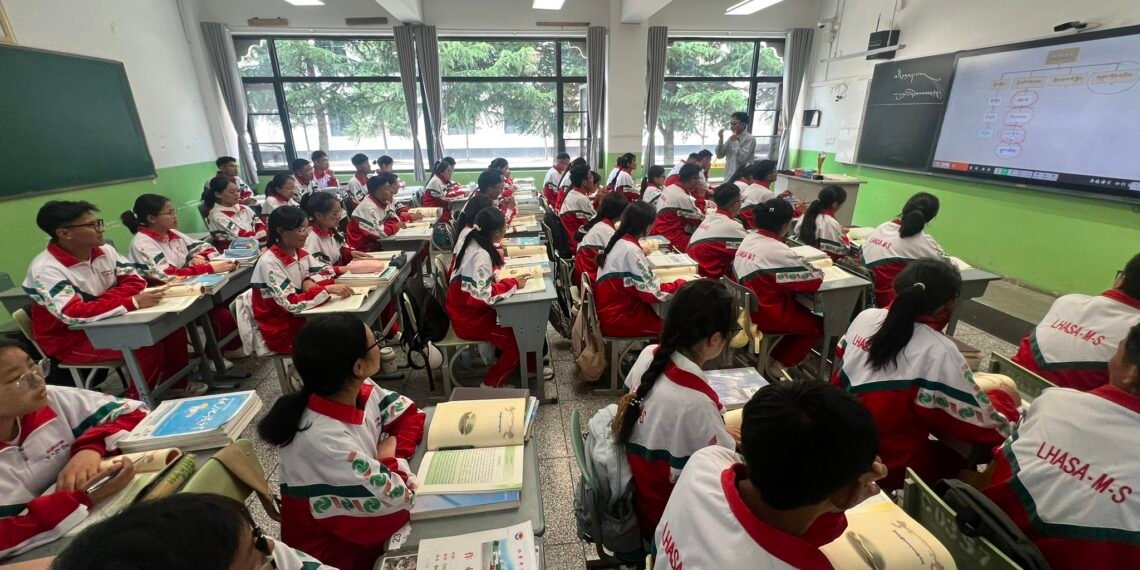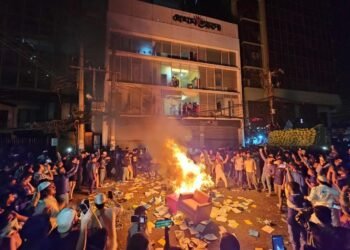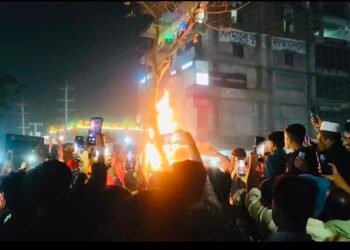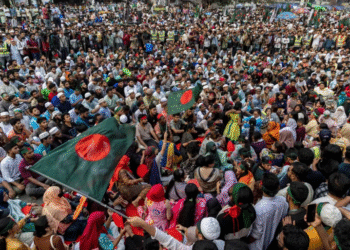In the remote highlands of Tibet, a silent crisis is unfolding. Tibetan children as young as four are being separated from their families and placed in Chinese-run colonial boarding preschools—institutions designed to erase their language, faith, and identity.
This is the first part of a five-part investigative series, “Erasing Tibet: How China is Targeting a Generation to Break a Nation,” beginning with Part 1: “When They Come, They Take Away Our Children”—an inside look at how China’s assimilation campaign begins in early childhood.
BY Navin Upadhyay
In the windswept towns and valleys of Tibet, the laughter of children is being replaced by silence. According to a powerful new report by the Tibet Action Institute titled When They Came to Take Our Children, the Chinese government is accelerating a campaign to separate Tibetan children—some as young as four years old—from their families and communities, placing them into a vast and deliberately concealed system of colonial boarding preschools.
This is not simply a story of educational reform. It is a methodical strategy to erase the cultural identity of a people.
“Making children as young as five to six years old stay at boarding school is unimaginable. It’s totally wrong,” said one Tibetan from inside Tibet quoted in the report.
‘He Tried to Climb Out of the Window’
Among the most haunting testimonies in the report is that of a Tibetan exile, now living abroad, who recounted how a close relative in Tibet was forced to leave his five-year-old son at a government-run boarding preschool.
“He told the teacher: ‘When I drop him off, I’ll have a short conversation with him and then I’ll leave. I’ll tell my son that I need to step out briefly. You need to tell him, ‘Your father will come back soon.’ And then, no matter how hard he cries, you lock the door as I walk away,’” the father said.
“My relative told me that he could hear his son crying crazily. He tried to climb out of the window, but my relative had to leave him there, like that.”
Preschool Behind Closed Doors
The report reveals that these boarding preschools—especially prevalent in rural Tibetan regions like Ü-Tsang, Golok, and Ngaba—are frequently housed within primary schools and do not appear in official records. This invisibility is by design. Researchers note that on platforms like Google Maps or Baidu, only the primary schools are listed. The boarding preschools, though co-located, are not publicly acknowledged.
READ: Pema Khandu: The Quiet Warrior Standing Tall Against China
Despite the secrecy, the scale is staggering. Educational sociologist Dr. Gyal Lo, who escaped from Tibet and now works with the Tibet Action Institute, estimates that at least 100,000 Tibetan children between the ages of three and six are being housed in residential institutions. In some counties in Kanlho and Ngaba, internal datasets reviewed by the institute show thousands of preschoolers boarding, with some schools hosting hundreds at a time.
🏔️ Tibet’s children forced to take 🧠 CCP 🇨🇳 loyalty tests in class
Military style chants of party slogans before breakfast.
🎓 Childhood isn’t a battleground. ♻️ SHARE to Help to increase 🌏awareness of this abuse and cultural erasure #FreeTibetanYouth #StopBrainwashing pic.twitter.com/VA6booUxvM— tibettruth (@tibettruth) July 11, 2025
‘After 8:30, We Took Them Back to the Dormitory’
In an online diary cited in the report, a Chinese student-teacher interning at a preschool in Kanlho Prefecture wrote:
“It looks very big, but it is actually a kindergarten [preschool] attached to a primary school. There are 30 children in the senior class and 10 in the middle class…
After 8:30 [p.m.], we took them back to the dormitory, and our work for the day was over.”
Children stay at the school from Sunday to Friday, separated from their families for most of the week. Most are not yet fluent in Mandarin when they arrive—Tibetan is their first language—but classroom instruction is conducted exclusively in Chinese, rapidly eroding their connection to their mother tongue and culture.
Boarding Is Not About Distance
Chinese authorities claim that boarding is necessary to provide access to education in remote, mountainous regions. But a 2023 study cited in the report shows this argument doesn’t hold. Nearly 70% of Tibetans live within 30 minutes of a school, and 87% live within an hour. In many cases, children are made to board even when schools are in their own towns or neighborhoods.
“Even though the boarding school is nearby, the parents were not given a choice about whether their children boarded or not,” one Tibetan insider explained. “People think the authorities have to meet a quota of children in preschool boarding.”
This practice is not about access—it is about control.
A Colonial Blueprint in Modern Disguise
The Tibet Action Institute argues that the system amounts to a modern-day colonial strategy. It is a deliberate attempt to break the generational transmission of Tibetan language, spirituality, and identity by capturing children during their most formative years.
READ: Myanmar Horror: Junta Bombs Monastery Shelter, Killing 28 in Sagaing
“The damage is not just to individuals,” says Dr. Gyal Lo in the report, “but to the Tibetan people as a whole. Once the mother tongue is gone, and the connection to family and faith is severed, what remains?”
A Silent Crisis, A Global Responsibility
Though the Chinese government has branded these programs as tools of “development” and “poverty alleviation,” the lived reality for many Tibetan families tells a far different story—one of heartbreak, fear, and loss. The United Nations has condemned the system, calling for its abolition, yet international action remains limited.
“This is a war not fought with guns, but with chalkboards and bunk beds,” said a senior Tibet Action researcher. “It’s psychological warfare aimed at erasing a people through their children.”













